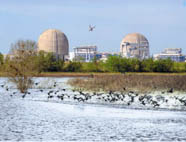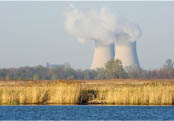Archive for the ‘Nukes’ Category
Opposition to Expansion of South Texas Project
60-Day Clock For Nuclear Opponents Starts Ticking: Opposition to Expansion of South Texas Project in Place


For Immediate Release
February 20, 2009
Contacts:
Karen Hadden, Director, SEED Coalition, 512-797-8481
Susan Dancer, Director, South Texas Association for Responsible Energy, 361-588-2143
Cindy Wheeler, Consumers’ Energy Coalition, 210-367-8510
Matt Johnson, Public Citizen’s Texas Office, 512-637-9453
AUSTIN, TX The NRC posted notice today on the Federal Register regarding the opportunity to intervene in the application of South Texas Nuclear Operating Company (STPNOC) to build two reactors at the South Texas Project (STP) nuclear plant site, near Bay City. Citizens now have
only 60 days to prepare and present their legal case in opposition to the reactors. Citizen groups are opposing the proposed reactors, including the newly formed Bay City based organization, South Texas Association for Responsible Energy (STARE), Sustainable Energy and Economic Development (SEED) Coalition, Public Citizen, and others who will intervene in the case.
“New reactors would saddle homeowners and taxpayers with additional debt for infrastructure, more radioactive waste that would sit in our community, and more risk of nuclear accidents, health impacts and radioactive exposure” said Susan Dancer, Director of the South Texas Association for Responsible Energy in Bay City, Texas. “These are among the many reasons we will intervene in opposition to more nuclear reactors.”
“CPS Energy has been stealthily and irresponsibly getting San Antonio deeper and deeper into this nuclear boondoggle, which is already raising our utility rates," said Cindy Weehler of the Consumers’ Energy Coalition. “There are cleaner, more affordable ways to generate electricity. Energy efficiency should be prioritized, not put on a back burner. With the economic downturn, we shouldn’t generate power that’s not needed. San Antonio has reduced energy use by 16% over the past two years. Why should we even consider antiquated reactors that could cost $17.5 billion and would leave radioactive waste for generations to come?”
“The streamlined combined construction and operating license process is designed to cut citizens out and limit public involvement. Safety concerns are taking a backseat to cost-cutting measures and the public doesn’t even know it yet.” said Karen Hadden, Executive Director of the Sustainable Energy and Economic Development (SEED) Coalition.
Nuclear opponents point out the troubled history of existing STP Units 1 & 2, reactors which ran six times over budget and were eight years late coming online. This sordid history includes harassment and illegal firing of employees who lodged safety complaints, theft of materials, subcontractor price-fixing schemes, and falsification of quality assurance/quality control reports. Before either unit was in operation The Austin Light newspaper reported on February 17, 1988, “There are currently more than 650 allegations concerning safety, costs and criminal activities brought by people who have worked on the project.” NRC Region IV became a target for a US Senate committee investigation for “corrupt” oversight of construction practices at STNP and Comanche Peak, another Brown and Root project. Sen. John Glenn said the agency is “more lapdog than watchdog.”
STPNOC includes NRG and CPS Energy, the municipal utility in San Antonio. Austin Energy, a partner in existing reactors at the site, has declined to participate in the proposed expansion. An indefinite suspension of the license hearing was obtained through a petition SEED Coalition filed last year, based on the incomplete nature of the application. That suspension has now ended with the notice issued today by the NRC on the Federal Register regarding the public’s opportunity to request participation in the hearing regarding the South Texas Project COL. The deadline for filing a request to participate is April 21. Citizens must develop their contentions, their legal case, during this extremely short time period, despite the fact that further revisions of the application are still anticipated.
The notice is entitled “South Texas Project Nuclear Operating Company Application for the South Texas Project Units 3 and 4; Notice of Order, Hearing, and Opportunity To Petition for Leave To Intervene”. This federal register notice was published as Volume 74, No. 33, pages 7934-7938.
The federal register notice along with information regarding the history of the existing ST(N)P reactors will also be posted at www.NukeFreeTexas.org.
South Texas Nuclear Project-The Record

NRC Image of South Texas Project, Units 1 & 2
The controversial nuclear power plant was delivered more than five times over the construction budget and seven years behind schedule.
STNP began construction in 1976, with a promised completion in 1981. Instead, Unit 1 construction was finished seven years late in 1988, and Unit 2 in 1989.
The initial cost estimate made in Dec. 1973 was $964 million-but actual costs ballooned more than five-fold to $5.5 billion.
History of a Troubled Project
Dec. 6, 1971 Houston Lighting & Power Co. (HL&P), the City of Austin, the City of San Antonio, and the Central Power and Light Co. (CPL) initiate feasibility study of constructing a jointly-owned nuclear plant.
1972 A construction company, Brown and Root (Halliburton), lobbies HL&P to win the STNP contract. B&R states in a letter to the utility that the project can be completed for $424 million and offers a $1 million "inducement" check to HL&P.
Sep. 9, 1972 Austin voters decline $289 in bonds for STNP participation.
May 15, 1973 Austin Mayor Pro-Tem Dan Love says the city’s failure to approve nukebonds is "tragic."
Jun. 6, 1973 HL&P and CPL announce their plans to build the South Texas Project nuclear plant in Matagorda County on the Texas coast. The initial official cost estimate for the plant: $964 million.
Jun. 28, 1973 The San Antonio City Public Service (CPS) Board signs a participation agreement to become an owner of STP.
Aug. 6, 1973 Brown & Root named project engineer and constructor.
Sep. 5, 1973 Austin Chamber of Commerce urges STNP participation, saying this is the only way to meet projected demands for electricity in 1982.
Nov. 18, 1973 Austin voters narrowly approve participation in STNP.
Dec. 1, 1973 Austin signs nuke contract with HL&P.
May 19, 1974 Application for plant construction permit submitted to the Atomic Energy Commission, predecessor agency to the Nuclear Regulatory Commission (NRC).
Dec. 22, 1975 NRC issues construction permits for Unit 1 and 2. HL&P is to be managing utility partner for construction and operation.
Sep. 24, 1981 Project completion is forecast for June 1989-four years behind schedule. More cost overruns are announced, with final costs estimated at $4.4 to 4.8 billion, more than four times initial estimates. Brown and Root gets fired as architect. Bechtel Energy Corp. is hired as project’s new architect/engineer. Brown & Root remains on as project builder.
Dec. 26, 1981 Owners commence breach of contract lawsuit against Brown & Root, which then withdraws as the project’s construction contractor.
Nov. 3, 1981 Austin voters authorize sale of the city’s 16 percent interest in the STP. No buyers are found.
Feb. 15, 1982 Ebasco Constructors hired to replace B&R as construction contractor.
Jan. 6, 1983 City of Austin sues HL&P for alleged mismanagement of construction.
May 30, 1985 A settlement of the Brown & Root lawsuit with project partners is announced. B&R agrees to pay STNP’s owners $750 million.
Jul. 2, 1986 Audit by Texas Public Utility Commission (PUC) finds that $1.1 to $1.3 billion of $5.5 billion construction costs were due to "imprudent mismanagement." PUC says these figures are over and above the $750 million provided by B&R in settlement.
1987 A Washington, DC watchdog group, the Government Accountability Project (GAP), receives complaints of safety related defects in construction and engineering from three dozen former and current project employees. Alleged crimes committed include: harassment and illegal firing of employees who lodged safety complaints; theft of materials; subcontractor price-fixing schemes; and falsification of quality assurance/quality control reports.
Aug. 12, 1987 Additional overruns of $100 million announced, bringing total project pricetag to $5.5 billion. San Antonio Mayor Cisneros vows to sue HL&P if further overruns occur.
Sep. 1987 Austin reaches tentative agreement to give HL&P its share of STNP in exchange for 400 megawatts of replacement power. Austin’s City Council refuses to hold hearings on GAP allegations to keep the negotiations alive. The deal ultimately comes apart when other partners refuse to share any costs of settlement with HL&P.
Oct. 16, 1987 PUC conducts hearings on STNP. The agency says a finding on whether or not it is economical to finish Unit 2 will be delivered in 1988-three years after PUC first ordered the study. Contrary to Mayor Cisneros’ professed dissatisfaction, the San Antonio Express News reports that CPS told the PUC that it is "satisfied with STP progress."
Nov. 8, 1987 San Antonio Express News says fifty-seven plant employees are alleging widespread and serious safety hazards in a ‘whistleblower’ complaint to the NRC. HL&P admits to the federal agency that two of their workers falsified inspection reports.
Mar. 8, 1988 Unit 1 goes critical; enters commercial operation on Aug. 25.
Mar. 18, 1988 NRC fines HL&P $75,000 for safety violations.
Feb. 17, 1988 The Austin Light newspaper reports, "There are currently more than 650 allegations concerning safety, costs and criminal activities brought by people who have worked on the project." NRC Region IV becomes a target for a US Senate committee investigation for allegedly "corrupt" oversight of construction practices at STNP and Comanche Peak, another B&R project. Sen. John Glenn says the agency is "more lapdog than watchdog."
Jan. 1989 Fire causes a leak and loss of cooling, causing reactor scram.
Mar. 12, 1989 Unit 2 reached initial criticality; goes into commercial operation Jun. 19.
Jul. 15, 1989 State court in Dallas unanimously rules HL&P doesn’t owe Austin any damages for construction project mismanagement.
Mar. 1991 Cracked fuel injector nozzles are found and have to be replaced.
Dec. 1991 Valve fails to open, a causing rapid decrease in reactor pressure and forcing a scram.
Dec. 1992 STNP management claims records for electric generation by a Westinghouse reactor in a single fuel cycle (Unit 1) and for a US reactor in a calendar year (Unit 2). However, in late December, a series of pump malfunctions begins in both units.
Feb 1993 Both units are taken offline to resolve problems with steam-driven auxiliary feedwater pumps. They will not return to service until March (Unit 1) and May (Unit 2) of 1994. NRC fines HL&P $500,000 for safety violation and places STNP on a "watch list" of facilities with serious safety-related issues.
Feb. 16, 1994 NRC chair Ivan Selin tours STNP and declares plant "as well designed and as good a physical facility as there is in the United States."
Feb. 22, 1994 City of Austin sues HL&P for $120 million in damages resulting from the shutdown, including $51 million in higher electricity costs for utility customers.
Dec. 31, 1995 STNP management claims national and global records for electric generation due to improving operations.
May 1, 1996 HL&P and the City of Austin reach an out-of-court settlement. Austin agrees to drop all litigation against HL&P; both parties agree to form a separate operating company to run STP.
Dec. 1996 Control rods for Unit 1 fail to insert properly into reactor core.
Jul. 1999 Emergency diesel generator is inoperable for three days.
Dec. 2002 Four massive steam generators are replaced in Unit 2.
2003 Unit 1 shut down after inspection during refueling reveals coolant leaks.
Feb. 9, 2005 Unit 2 shut down due to cooling system leaks.
Jun. 19, 2006 NRG Energy files a Letter Of Intent with the NRC to build two 1358-Mwe Advanced Boiling Water Reactors at the South Texas Project site.
Sep. 24, 2007 NRG filed a full application with the NRC to build two GE ABWRs at the STNP site. This is the first full application for a new reactor to the NRC since 1979. The proposed expansion would generate an additional 2,700 MW of electrical generating capacity, doubling the size of the existing STNP complex.
Dec. 11, 2007 San Antonio Express News says, "Planning for an addition to the South Texas Project nuclear plant is costing CPS Energy $206 million." The newspaper reports CPS contributed half of $80 million for the NRC application.
Cancer questions grow around Fermi
Cancer questions grow around Fermi nuclear plant
State health report shows 31 percent increase in cancer rate among young people in Monroe County since 1996

2/17/09
By Eartha Jane Melzer
Michigan Messenger
The cancer rate among people under the age of 25 in Monroe County rose at more than three times the rate of the rest of the state between 1996 and 2005, according to a report generated by the Michigan Department of Community Health (MDCH). Between 1996 and 2000, the average rate of cancer cases for this group was 18.5 cases per 100,000 people; between 2001 and 2005, the rate grew to 24.3 per 100,000. Between 1996 and 2000 the statewide rate of cancer for this group was 20.2 per 100,000; between 2001 and 2005, the rate was 21.9.
Spectacular $50 Billion No Nukes Victory
Another Spectacular $50 Billion No Nukes Victory for the Forces of Solartopia
By Harvey Wasserman
February 12, 2009
For the third straight year, against all odds, a national grassroots No Nukes campaign has stripped out of the federal budget a proposed $50 billion boondoggle for new atomic
reactors.
The victory gives a giant boost to solar, wind, efficiency, mass transit and other Solartopian technologies that can solve global warming, sustain real economic growth and bring us a truly green-powered Earth.
This latest victory came Wednesday, February 11, as a top-level Congressional conference committee ironed out the last details of the Obama stimulus package. The loan guarantee scam was slipped into the Senate version by Republican Bob Bennett (R-UT) in cooperation with Democrat Tom Carper (D-DE). The loan guarantees would have backed a Department of Energy program supporting new reactor construction, despite a report from the Government Accountability Office warning that such projects would bankrupt more than half the utilities that might undertake them.
A national grassroots campaign involving virtually all major environmental organizations dealing with energy once again underscored the overwhelming green opposition to atomic power. The Nuclear Information & Resource Service, Beyond Nuclear, Physicians for Social Responsibility, Environment America, NukeFree.org, Greenpeace, the Natural Resources Defense Council, IEER, Center for American Progress, Taxpayers for Common Sense, Friends of the Earth, Sierra Club, Rainforest Action, Rainforest International and more than 200 national and local environmental and taxpayer organizations joined in opposition to the guarantees.
It is not yet clear but seems likely key impetus on the Hill may have come from House Speaker Nancy Pelosi (D-CA), Senate Majority Leader Harry Reid (D-NM) and House committee chairs Henry Waxman (D-CA), David Obey (D-WI) and Ed Markey (D-MA), among others. Gestures of thanks are being widely encouraged.
A similar victory was won in the fall of 2007 when a $50 billion loan guarantee was slipped into the national energy bill by then-Senator Pete Domenici (R-NM). The campaign prompted a song from Bonnie Raitt, Jackson Browne, Graham Nash, Ben Harper and Keb Mo posted at www.nukefree.org. With the help of Moveon.org, it delivered more than 120,000 signatures to Congress in less than three months.
In 2008 the industry was forced to withdraw a blank check loan guarantee program when the banking system collapsed.
This year’s attempt came in the dead of night, with virtually no public knowledge. Only Amy Goodman’s DEMOCRACY NOW! Gave it national television coverage, while Richard Greene’s CLOUT on Air America and the Peter B. Collins show featured national radio play.
No significant story about the plan appeared in the New York Times, USA Today or other major media outside Washington.
The No Nukes victory came within hours of the passing of Guy Chichester, a legendary founder of the Clamshell Alliance and National Green Party. Chichester helped lead the mass demonstrations at the Seabrook (NH) nuclear site that thrust the atomic power issue into the global limelight. In the 1977 LAST RESORT (www.gmpfilms.com) Guy became one of the first to speak on film about a green-powered Earth, arguing that the money being squandered on Seabrook should instead go to renewable energy which would create thousands of jobs and save the planet. As a green pioneer, Chichester’s innumerable—often humor-filled—non-violent arrests were matched only by his great heart and loving spirit.
Ironically, this latest push for reactor subsidies coincides with what may be a death blow to the proposed Yucca Mountain radioactive waste dump. Opposed by both Reid and President Obama, the multi-billion-dollar project may be defunded. After a half-century, the US has no high level nuke waste repository, and none planned.
No one expects an end to the industry’s relentless assault on the taxpayer trough. New reactor cost estimates have tripled since 2007 and are likely to at least double again. Michael Mariotte of NIRS says pro-nukers now want atomic energy labeled “green” in a national renewable energy standard. As Kevin Kamps of Beyond Nuclear points out,
additional attempts to get money are likely to follow in upcoming debate on an Energy Bill and other legislation.
But as renewables and efficiency and the movement supporting them surge ahead, the Solartopian vision of a truly green planet, free of fossil/nuke power, becomes ever more
real.
Harvey Wasserman’s SOLARTOPIA! Our Green-Powered Earth, is at www.harveywasserman.com. He edits the NukeFree.org web site, and is senior editor of www.freepress.org, where this article first appeared.
This document contains copyrighted material whose use has not been specifically authorized by the copyright owner. SEED Coalition is making this article available in our efforts to advance understanding of ecological sustainability, human rights, economic democracy and social justice issues. We believe that this constitutes a “fair use” of the copyrighted material as provided for in section 107 of the US Copyright Law. If you wish to use this copyrighted material for purposes of your own that go beyond “fair use”, you must obtain permission from the copyright owner.
$50 billion radioactive antique toilet
Why is that $50 billion radioactive antique toilet still in the stimulus
bill?
Harvey Wasserman
February 10, 2009
The infamous $50 billion nuke power loan guarantee package meant to use your money to
build new nuke reactors has gone missing from saturation media coverage of Obama’s
Stimulus Package. But it’s still in the Senate version of the bill, it could be voted on this
week, and it could kill us all.
Like that $30,000 antique toilet that disappeared into the banking bailout, the corporate
media carries not a word about this gargantuan handout to the dying reactor industry. All
the hype about a “nuclear renaissance” will come to naught without this massive taxpayer
handout. But if it goes through, the landscape could be pock marked with lethal new nukes.
We have days—maybe hours—to stop it. While aid programs to the states, for education
and the truly needy are slashed, this gargantuan boondoggle is poised to sail through with
virtually no public knowledge.
The loan guarantee package was slipped into the Senate version of the Stimulus Bill by
Senator Robert Bennet (R-UT) who proceeded to vote against the overall package. It is not
currently in the House version.
As the two bills are reconciled, armies of radioactive lobbyists will be marching through the
Halls of Congress. They know Wall Street will never pay for new nukes, so that leaves…you
and me!
The estimated price of building new reactors has nearly tripled since the beginning of
2007. It is virtually certain to at least double again before any new nuke could come on line,
which could not happen in less than a decade.
Reactors built from the 1960s to now came on line an average of 200% and more over
budget. A French-based reactor construction project in Finland has soared more than $2
billion over budget and is more than two years behind schedule. The Government
Accountability Project warns that at least half those who build new reactors are likely to
plunge into bankruptcy. To this day the industry cannot get private insurance to cover the
full potential liability of a reactor catastrophe.
But Bennett’s maneuver, supported by Senator Tom Carper (D-DE) would divert billions
away from renewables and efficiency, and into these failed terror targets.
Calls and letters are desperately needed to the Congressional leadership—NOW!— to flush
this horrific boondoggle out of the stimulus package. With White House pressure mounting
to get it passed this week, every minute counts.
Numerous major national environmental organizations offer websites from which to sign
on and send letters, including www.nirs.org , www.beyondnuclear.org and
www.nukefree.org. The Congressional phone line is 202-224-3121 or (toll free) 800-962-
3524.
Do not hesitate: the melt-down you prevent could otherwise kill you; the money redirected
to green alternatives could save our planet…and our economy.
Harvey Wasserman’s SOLARTOPIA! Our Green-Powered Earth, is at www.harveywasserman.com. He edits the NukeFree.org web site, and is senior editor of www.freepress.org, where this article first appeared.
This document contains copyrighted material whose use has not been specifically authorized by the copyright owner. SEED Coalition is making this article available in our efforts to advance understanding of ecological sustainability, human rights, economic democracy and social justice issues. We believe that this constitutes a “fair use” of the copyrighted material as provided for in section 107 of the US Copyright Law. If you wish to use this copyrighted material for purposes of your own that go beyond “fair use”, you must obtain permission from the copyright owner.


